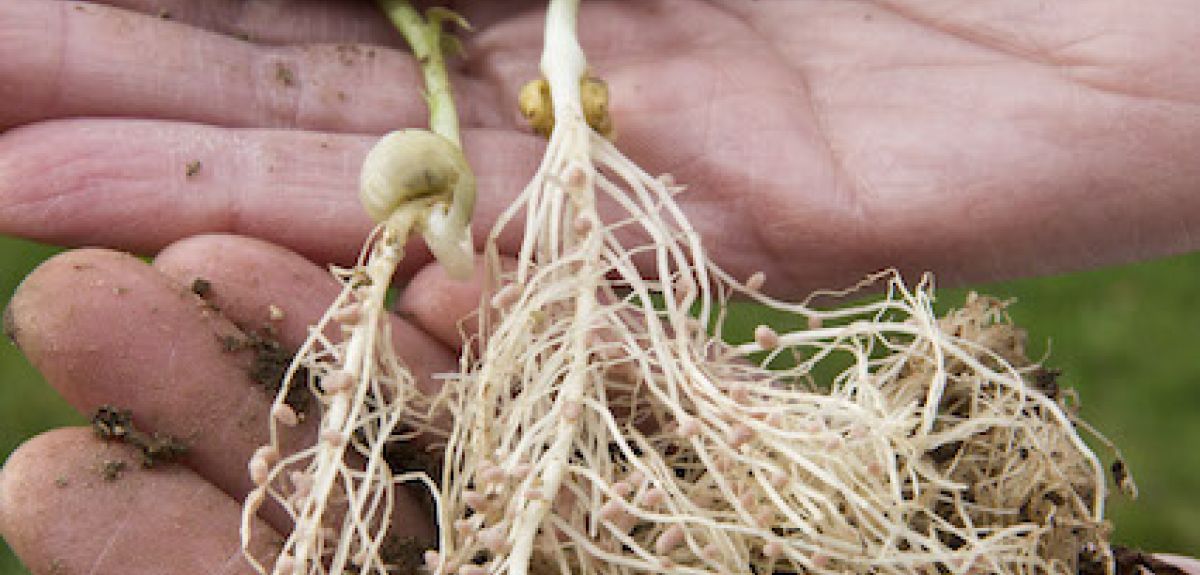
beans root
New Oxford University research will help optimize environmentally friendly ways of fertilising plants
New research from the University of Oxford’s Departments of Plant Sciences and Engineering, as well as collaborators at VU Amsterdam, uses both mathematical modelling and experimental validation to study the metabolic processes controlling how bacteria provide ammonia to legumes, which is vastly important for sustainable agriculture
Ammonia-based fertiliser is commonly used in industrial agriculture, and since the early 20th C. this has been provided by industrially produced ammonia. Whilst this does increase crop yields, it has had a catastrophic impact on the environment. This is partly because of the energy it takes to both make the ammonia, and partly because half of the ammonia in these fertilisers goes into the soil and rivers, causing massive harm to our oceans, as well as leading to release of huge amounts of the potent greenhouse gas nitrous oxide.
Before the invention of industrially produced ammonia, legumes have been used in farming for thousands of years, because of their ability to develop nodules on their roots which house bacteria called rhizobia. The rhizobia take nitrogen from the air and turn it into ammonia fertilizer for the plants, and in turn the plants use photosynthesis to provide the bacteria with energy and nutrients. Understanding more about this process of naturally produced ammonia is pivotal in the development of more sustainable agriculture.
This research, led by DPhil candidate Carolin Schulte, used a novel approach of largely unbiased mathematical modelling to understand more about the relationship between the legumes and rhizobia. This modelling shows how this symbiosis functions metabolically and increases our understanding of how the host plant and the rhizobia interact. Previous modelling typically involves uses assumptions based on existing experimental evidence, which often means that results are biased towards what researchers expect to see. However, by minimising assumptions in the mathematical modelling, Schulte was able to generate novel insights into rhizobial metabolism during nitrogen fixation, which were then backed up by experimental validation.
Schulte says, ‘Biological nitrogen fixation is one of the key processes enabling more sustainable agricultural practices and has been the subject of extensive research efforts for decades. However, once rhizobia are inside nodules, it becomes very difficult to directly measure changes in their metabolism. We therefore decided to combine modelling approaches with experimental data, which enabled us to explain some of the fundamental mechanisms governing metabolism during nitrogen fixation. This was only made possible through a great collaborative effort bringing together the work done by several DPhil students over the course of many years.’
Being able to genetically select more efficient rhizobia has a clear and direct environmental benefit, and also allows us to know more about what would be needed to synthetically engineer nodules that could host them. By understanding this process and selecting the right legumes to increase production of ammonia, and in turn increase crop yield, we can expect real benefits to tackle problems of increasing food demand.
Unexpectedly, this research discovered that in order to acquire ammonia from the rhizobia, the plant effectively starves the bacteria of oxygen. Rhizobia are reluctant to share the ammonia they create with their host plant, so by choking their metabolism they must give the ammonia created to the plant.
‘While we always knew oxygen levels needed to be low in nodules, legumes have taken this to an extreme to exert exquisite control of the metabolism of rhizobia. This work is an excellent example of collaborative research between microbiologists, plant biologists and engineers bringing together the complementary mathematical and experimental skills needed for this breakthrough,’ says Professor Philip Poole, who supervised this research.
Moving forward, the researchers plan to identify which processes and metabolic steps limit the rate of fixation. This builds upon previous similar research around photosynthesis which has seen up to a 35% increase in photosynthesis in the field, so by using similar methods to improve nitrogen fixation, this could work towards making more efficient crops.
 New study finds that stopping weight-loss drugs is linked to faster regain than ending diet programmes
New study finds that stopping weight-loss drugs is linked to faster regain than ending diet programmes
 Honorary degree recipients for the Chancellor’s ceremony announced
Honorary degree recipients for the Chancellor’s ceremony announced
 Expert Comment: The illegality of the US attack against Venezuela is beyond debate - how the world reacts is critical
Expert Comment: The illegality of the US attack against Venezuela is beyond debate - how the world reacts is critical